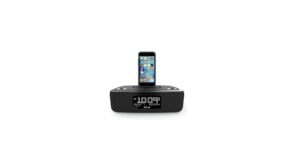IHome iW18 POWERVALET Compact Alarm Clock User Manual

FEATURES & FUNCTIONS
BACK PANEL


GETTING STARTED
Connecting the Unit
Before use, remove the battery pull tab from the bottom of the unit. Connect the included AC adapter to the DC jack located on the back of the unit and connect the other end to a working wall outlet.
Setting Your Clock
- Press and hold the Time Set Button until the display flashes.
- Press the – or + Buttons to adjust selections and press Time Set to confirm.
- Do this for time, year, month, and date.
- All done!
Daylight Savings Time (DST) Switch:
By default, the DST Switch is set to Auto and will automatically adjust the time each March and November.
DISPLAY ICONS

To adjust the brightness of the display, press the Time Set Button repeatedly to cycle through brightness settings, including OFF.
SETTING THE ALARM
Note:
Each step must be completed while the display is flashing or the setting will time-out with any changes saved.
- Press and hold the Alarm Button for 2 seconds until the alarm time display and alarm icon flash.
- Press the – or + Buttons to adjust the alarm time to the desired time (hold for rapid setting). Make sure you set the correct AM/PM alarm time. The PM indicator appears to the left of the display.
- Press the Alarm Button to confirm the alarm time setting. The alarm schedule will flash 7 (every day), 5 (weekdays) or 2 (weekend only). Press the – or + Buttons to select the desired alarm schedule.
- Press the Alarm Button to confirm the alarm schedule. 2 beeps will confirm alarm setting is complete. The alarm icon will remain on the display, indicating the alarm is armed.
- To turn off a sounding alarm and reset it to come on the next day at the same time, press the Alarm Button to reset alarm.
PREVIEWING THE ALARM
Press and release the desired Alarm Button as needed to preview the alarm and to toggle the alarm ON (indicated by the alarm icon) or OFF (no alarm icon).
PROGRAMMABLE SNOOZE

- To program Snooze, press down on the front of the unit for 2 seconds during normal operation (when no alarm is sounding).
- Press the – or + Buttons to select a snooze time (between 01 and 29 minutes).
- Press down and release the front of the unit to confirm the setting. While the alarm is sounding, press down on the front of the unit to temporarily silence the alarm (9 minutes is the default). Snooze can be used several times during the one-hour alarm cycle.
USB CHARGING

Connect the standard size end of a USB cable (not included) to the USB port on the back of the unit and connect the other end to the charging port on your device. (Make sure the unit is plugged into a working outlet in order to charge devices.)
BATTERY BACK-UP
The unit comes with a CR-2450 backup battery installed to provide continuous alarm operation and clock settings in the event of a temporary power failure. Remove the battery pull tab before use. When the battery icon on the clock display is flashing, it is time to replace the backup battery. The battery compartment is located at the bottom of the unit.

- Make sure the AC adapter is connected, or you will lose your time and alarm settings during battery replacement.
- Use a Phillips screwdriver to open the battery compartment door.
- Remove the exhausted battery from the compartment and insert 1 CR-2450 battery, checking that the + side is facing you. Replace the compartment door. Do not over-tighten.
WARNING:
Lithium batteries can explode or cause burns if disassembled, shorted, recharged, exposed to water, fire, or high temperatures. Do not place loose batteries in a pocket, purse, or other container containing metal objects, mix with used or other battery types, or store with hazardous or combustible materials. Store in a cool, dry, ventilated area. Follow applicable laws and regulations for transport and disposal.
IMPORTANT SAFETY INSTRUCTIONS
When used in a directed manner, this unit has been designed and manufactured to ensure your personal safety. However, improper use can result in potential electrical shock or fire hazards. Please read and follow all safety and operating instructions carefully before installation and use, and keep these instructions handy for future reference. Take special note of all warnings listed in these instructions and on the unit.
- Water and Moisture – The unit should not be used near water. For example: near a bathtub, washbowl, kitchen sink, laundry tub, swimming pool or in a wet basement.
- Ventilation – The unit should be situated so that its location or position does not interfere with its proper ventilation. For example, it should not be situated on a bed, sofa, rug or similar surface that may block ventilation openings. Also, it should not be placed in a built-in installation, such as a bookcase or cabinet, which may impede the flow of air through the ventilation openings.
- Heat – The unit should be situated away from heat sources such as radiators, heat registers, stoves or other appliances (including amplifiers) that produce heat.
- Power Sources – The unit should be connected to a power supply only of the type described in the operating instructions or as marked on the appliance. Only use the AC adapter that came with the unit.
Continued
- Power-Cable Protection – Power supply cables should be routed so that they are not likely to be walked on or pinched by items placed upon or against them. It is always best to have a clear area from where the cable exits the unit to where it is plugged into an AC socket.
- Cleaning – Clean only with dry cloth.
- Objects and Liquid Entry – Care should be taken so that objects do not fall and liquids are not spilled into any openings or vents located on the product.
- Attachments – Do not use attachments not recommended by the product manufacturer.
- Overloading – Do not overload wall sockets, extension cords, or integral convenience receptacles as this can result in a risk of fire or electric shock.
FCC INFORMATION
This equipment complies with FCC RF radiation exposure limits set forth for an uncontrolled environment. This device complies with Industry Canada’s license-exempt RSSs.
- Warning: Changes or modifications to this unit not expressly approved by the party responsible for compliance could void the user’s authority to operate the equipment.
- NOTE: This equipment has been tested and found to comply with the limits for a Class B digital device, pursuant to Part 15 of the FCC Rules.
IC Statement
This device contains license-exempt transmitter(s)/receiver(s) that comply with Innovation, Science and Economic Development Canada’s license-exempt RSS(s). (1) This device may not cause interference. (2) This device must accept any interference, including interference that may cause undesired operation of the device. The device meets the exemption from the routine evaluation limits in section 2.5 of RSS 102 and compliance with RSS-102 RF exposure, users can obtain Canadian information on RF exposure and compliance. This equipment should be installed and operated with a minimum distance of 20 cm between the radiator and your body.
REFERENCE LINK
https://www.ihomeaudio.com/iW18BG/





